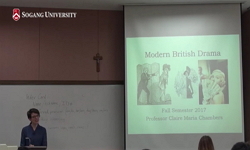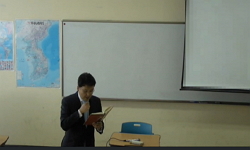1920~30년대 일본의 모더니즘은 신감각파, 신흥예술파, 신심리주의파의 세 파로 구성되어 있다. 신감각파의 대표인물은 요코미쓰 리이치(橫光利一)이며, 주요 특성은 ‘전통문학에 대한 거부...
http://chineseinput.net/에서 pinyin(병음)방식으로 중국어를 변환할 수 있습니다.
변환된 중국어를 복사하여 사용하시면 됩니다.
- 中文 을 입력하시려면 zhongwen을 입력하시고 space를누르시면됩니다.
- 北京 을 입력하시려면 beijing을 입력하시고 space를 누르시면 됩니다.
https://www.riss.kr/link?id=A76445886
- 저자
- 발행기관
- 학술지명
- 권호사항
-
발행연도
2006
-
작성언어
-
-
주제어
모더니즘 ; 신감각파 ; 신흥예술파 ; 신심리주의파 ; 요코미쓰 리이치 ; 류탄지 유 ; 이토 세이 ; 반전통 ; 감각주의 ; Japanese modernism ; new sensualism ; Newly Rising Artists ; new psychologist ; Yokomits Liits ; Rhyu Tangi ; Ito Sei ; anti-traditionalism ; sensualism.
-
KDC
800
-
등재정보
KCI등재
-
자료형태
학술저널
- 발행기관 URL
-
수록면
26-42(17쪽)
- 제공처
-
0
상세조회 -
0
다운로드
부가정보
국문 초록 (Abstract)
신흥예술파의 대표작가는 류탄지 유(龍膽寺雄)이다. 그의 모더니즘은 난센스문학이다. 소화 초기에 문단에서는 의미가 없는 영역으로의 일탈을 즐기는 경향이 나타난다. 그 의미가 제거된 세계를 재현한 것이 난센스문학이다. 난센스문학의 특성은 현실의 모든 규범에서 일탈한 무정부적인 자유와 초탈, 옵티미즘(optimism) 등이다. 어버니즘(urbabism)의 정착과 도시 풍속의 선도, 모던 보이와 모던 걸로 대표되는 인물의 현대성 등이 류탄지 작품의 특성이다.
신심리주의파는 이토 세이(伊藤整)가 주도한다. 이토 작품의 특성은 ① 보다 현실에 卽한 스타일-새로운 현실 파악 ② 내면심리의 영토 확인- 의식의 흐름의 수법 채택 ③ 스타일에 대한 관심 ④ 내성적 주관적 의미의 분석적 방법 등이다. 그의 신심리주의 소설들은 이런 주장들의 육화를 위한 노력을 보여준다.
요코미쓰, 류탄지, 이토의 모더니즘은 실험의 다양성과 일관성, 낙관주의와 비관주의, 서정성, 어버니즘에 대한 태도 등에서 차이점이 발견된다. 공통점은 反전통의 자세, 좌파 문학에 대한 비판, 현실 이탈 현상, 감각주의, 사소설적 경향성 등이다.
1920~30년대 일본의 모더니즘은 신감각파, 신흥예술파, 신심리주의파의 세 파로 구성되어 있다. 신감각파의 대표인물은 요코미쓰 리이치(橫光利一)이며, 주요 특성은 ‘전통문학에 대한 거부’이다. 실제 작품에 나타난 구체적 특성은 ‘괴뢰(傀儡) 만들기’와 소설의 허구성 긍정, ‘擬眼’과 ‘複眼’ 등의 객관적 시점 등으로 이는 반(反)사소설적 경향을 보여준다. 또한 시공간의 현실 일탈, 플롯의 인과성 해체 등의 기법을 통해 反리얼리즘적 경향을 드러낸다. 더불어 감각적인 문체도 특징적이다.
신흥예술파의 대표작가는 류탄지 유(龍膽寺雄)이다. 그의 모더니즘은 난센스문학이다. 소화 초기에 문단에서는 의미가 없는 영역으로의 일탈을 즐기는 경향이 나타난다. 그 의미가 제거된 세계를 재현한 것이 난센스문학이다. 난센스문학의 특성은 현실의 모든 규범에서 일탈한 무정부적인 자유와 초탈, 옵티미즘(optimism) 등이다. 어버니즘(urbabism)의 정착과 도시 풍속의 선도, 모던 보이와 모던 걸로 대표되는 인물의 현대성 등이 류탄지 작품의 특성이다.
신심리주의파는 이토 세이(伊藤整)가 주도한다. 이토 작품의 특성은 ① 보다 현실에 卽한 스타일-새로운 현실 파악 ② 내면심리의 영토 확인- 의식의 흐름의 수법 채택 ③ 스타일에 대한 관심 ④ 내성적 주관적 의미의 분석적 방법 등이다. 그의 신심리주의 소설들은 이런 주장들의 육화를 위한 노력을 보여준다.
요코미쓰, 류탄지, 이토의 모더니즘은 실험의 다양성과 일관성, 낙관주의와 비관주의, 서정성, 어버니즘에 대한 태도 등에서 차이점이 발견된다. 공통점은 反전통의 자세, 좌파 문학에 대한 비판, 현실 이탈 현상, 감각주의, 사소설적 경향성 등이다.
다국어 초록 (Multilingual Abstract)
The representative writer of Newly Rising Artists is Rhyutangi Ryu(龍膽寺雄) who expresses Modernistic non-sense in his writing. He enjoys meaningless deviation in the time of early Sohwa period. The character- istics of non-sense literature is to enjoy anarchistic freedom and tran- scendence, and optimism. He leads manner of urbanity and describes characters of modernity what we called ‘modern boy’ in his novels.
Ito Sei(伊藤整) leads the school of New Psychologist. His writings implies 1) a style of modernity catching actual realities of life, 2) secures a domain of inner state of mind adopting stream of consciousness, 3) special concern about style to catch actuality, 4) using a methode of analysis to grasp introvert and subjective meanings. His New Psychologism tries to incarnate above mentioned insistences in his novels.
Yokomits, Rhyutangi and Ito show their different quality of modernism in their various experiments of writings: optimistic or pessimistic attitude towards life and view point of urbanism. Their common traits implies anti-traditionalism, a harsh criticism against the leftist writers, devious inclinations in actual life, sensualism and preference to “I-story” telling or against to it.
Japanese Modernism consists of three school: New Sensualists, Newly Rising Artists and New Psychologists. The representative writer of New Sensualists is Yokomits Liits(橫光利一), who refuses to accept traditional literature. He inclines to ‘mak...
Japanese Modernism consists of three school: New Sensualists, Newly Rising Artists and New Psychologists. The representative writer of New Sensualists is Yokomits Liits(橫光利一), who refuses to accept traditional literature. He inclines to ‘make puppets’, a positive attitude toward fiction and employs ‘an artificial eyes’ or double view point in his novels, which display anti-“I”story telling.
The representative writer of Newly Rising Artists is Rhyutangi Ryu(龍膽寺雄) who expresses Modernistic non-sense in his writing. He enjoys meaningless deviation in the time of early Sohwa period. The character- istics of non-sense literature is to enjoy anarchistic freedom and tran- scendence, and optimism. He leads manner of urbanity and describes characters of modernity what we called ‘modern boy’ in his novels.
Ito Sei(伊藤整) leads the school of New Psychologist. His writings implies 1) a style of modernity catching actual realities of life, 2) secures a domain of inner state of mind adopting stream of consciousness, 3) special concern about style to catch actuality, 4) using a methode of analysis to grasp introvert and subjective meanings. His New Psychologism tries to incarnate above mentioned insistences in his novels.
Yokomits, Rhyutangi and Ito show their different quality of modernism in their various experiments of writings: optimistic or pessimistic attitude towards life and view point of urbanism. Their common traits implies anti-traditionalism, a harsh criticism against the leftist writers, devious inclinations in actual life, sensualism and preference to “I-story” telling or against to it.
목차 (Table of Contents)
- Ⅰ. 서론
- Ⅱ. 신감각파(新感覺派)와 요코미쓰 리이치
- Ⅲ. ‘신흥예술파’와 류탄지 유(龍膽寺雄)
- Ⅳ. 신심리주의와 이토 세이(伊藤整)
- Ⅴ. 결론
- Ⅰ. 서론
- Ⅱ. 신감각파(新感覺派)와 요코미쓰 리이치
- Ⅲ. ‘신흥예술파’와 류탄지 유(龍膽寺雄)
- Ⅳ. 신심리주의와 이토 세이(伊藤整)
- Ⅴ. 결론
- 참고문헌
- 초록
동일학술지(권/호) 다른 논문
-
- 구보학회
- 김상태(Kim, Sang Tae)
- 2006
- KCI등재
-
- 구보학회
- 류수연(Ryu, Su Yeon)
- 2006
- KCI등재
-
- 구보학회
- 나은진(Rah, Eun Jean)
- 2006
- KCI등재
-
- 구보학회
- 김중철(Kim, Joong Chul)
- 2006
- KCI등재





 스콜라
스콜라






